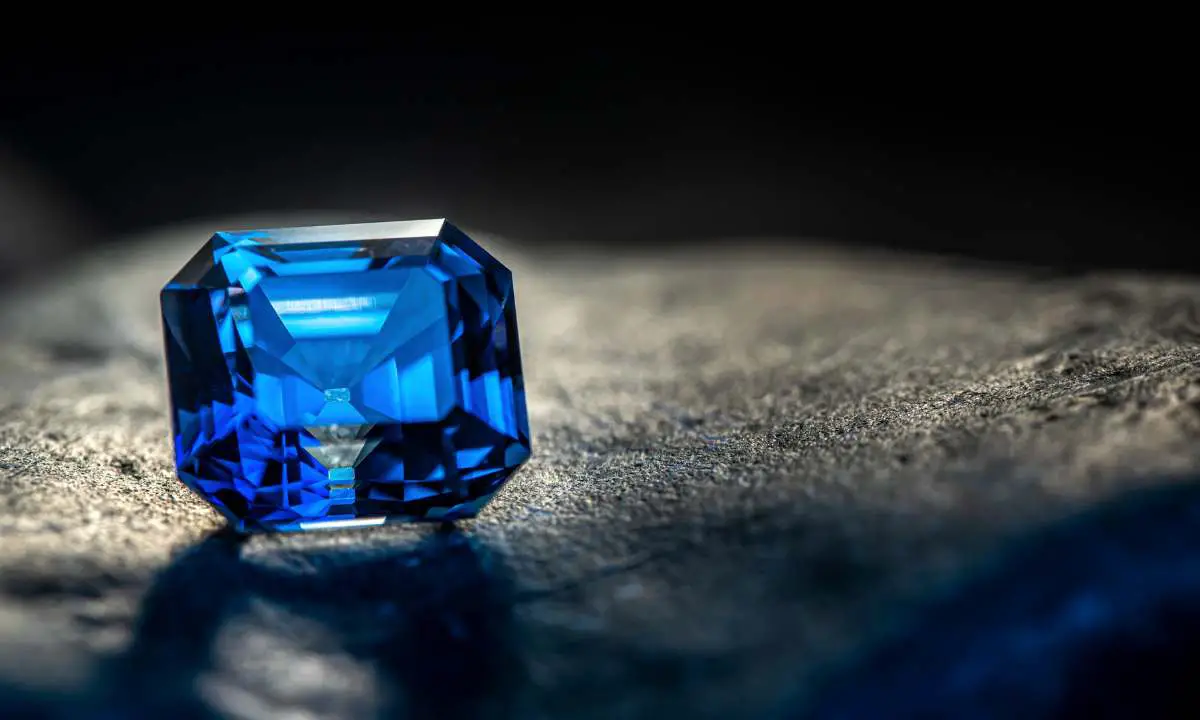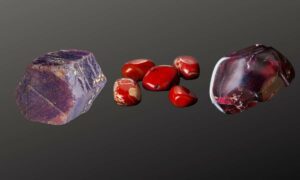Sapphire crystals aren’t just pretty rocks; they hold the power to unlock a world of mystery and wonder. From ancient folklore to modern-day technology, these dazzling gems have captivated humans for centuries.
Delve into the captivating realm of sapphire crystals and discover their fascinating meaning, significance, and the hidden secrets they hold. Get ready to be enchanted!
Introduction: A Brief Overview
When you think of sapphire crystals, you might immediately picture a stunning blue gemstone adorning a piece of jewelry. And while sapphires do come in various shades of blue, they also exist in a range of colors, from pink and yellow to green and even colorless.
But what exactly are sapphire crystals? Sapphires are a type of mineral known as corundum.
They’re formed deep within the Earth’s crust under intense heat and pressure, then brought to the surface through volcanic activity or erosion. While sapphires are found in mines all around the world, some of the most famous deposits can be found in Sri Lanka, Madagascar, Australia, and Montana.
But what makes sapphire crystals so special? For one thing, they’re incredibly hard – second only to diamonds on the Mohs scale – which makes them highly durable for use in jewelry making and industrial applications like watch faces and phone screens.
But beyond their physical properties lies a rich history and symbolism that has captivated people for centuries. In this article, we’ll explore the different meanings associated with sapphire crystals and how they’ve played an important role in various cultures throughout time.

What are Sapphire Crystals?
Sapphire crystals are a type of mineral that belongs to the corundum family. They are typically blue in color, but can also be found in a range of other colors. Sapphire is the second hardest mineral after diamond, making it exceptionally durable and ideal for use in jewelry and other applications.
Definition and Characteristics of Sapphire Crystals
Sapphire crystals are made up of aluminum oxide with trace amounts of titanium, iron, or chromium which gives them their distinct colors. The most common color for sapphires is blue, but they can also be found in shades of pink, yellow, green, purple, and even black. The color intensity is determined by the concentration level of certain elements during formation.
In addition to their beautiful appearance and hardness properties, sapphires also have excellent optical properties such as high refractive index and birefringence which makes them ideal for use in lenses and other optical applications. In addition to their durability and optical properties, sapphire crystals are also resistant to scratches which makes them an ideal material for watch faces or phone screens.
How Sapphire Crystals Are Formed In Nature
Natural sapphires form deep within the earth’s crust under extreme pressure and heat conditions over thousands if not millions of years. These conditions cause the minerals to crystallize into large gem-quality stones which are then extracted from mines all over the world such as Sri Lanka or Madagascar.
Synthetic sapphires on the other hand are created via a process called the Verneuil process where aluminum oxide powder is melted at extremely high temperatures before cooling down into crystal forms. These synthetic sapphires can be produced much more quickly than natural ones while maintaining many of their desirable properties.
Overall, sapphire crystals are a fascinating mineral with a diverse range of uses and a rich history. Knowing more about their formation and characteristics can enhance our appreciation of their beauty and practicality in various fields.
Readers recommend: The Ultimate Chakra Crystals Guide. What You Need to Know
Types of Sapphire Crystals
Natural vs Synthetic Sapphires
When it comes to sapphire crystals, there are two main types: natural and synthetic. Natural sapphires are formed naturally in the earth’s crust under extreme heat and pressure. They are typically found in sedimentary rock formations and mining is required to extract them from the ground.
The rarity of high-quality natural sapphires makes them quite valuable and expensive. On the other hand, synthetic sapphires are created in a laboratory using a process called the Verneuil process.
This involves melting aluminum oxide powder at high temperatures and letting it crystallize into a sapphire over time. Synthetic sapphires can be made in large quantities and at lower cost than natural sapphires, making them more accessible for industrial uses like watch faces and phone screens.
Different Colors and Variations of Sapphires
Sapphire crystals come in a variety of colors beyond the traditional blue that most people associate with this gemstone. In fact, almost every color of the rainbow is represented in some form of sapphire crystal!
Pink, yellow, green, orange, purple – you name it! The color variations occur due to differences in trace elements present during formation or through treatments applied after extraction.
For example, pink sapphires have traces of chromium or titanium while yellow ones contain iron impurities. Black sapphires actually lack any color whatsoever- instead appearing opaque or dark grey due to their mineral composition.
While blue is still considered the classic shade for a truly “precious” stone – these alternative colors offer unique beauty as well as sometimes more affordable alternatives to their blue counterparts. If you’re curious which color represents what meaning- don’t worry we’ll get there next!
The Symbolism and Meaning of Sapphire Crystals
Sapphire crystals have been a symbol of power, truth, and protection throughout history. In ancient Persia, it was believed that the earth rested on a giant sapphire, lending the stone an association with stability and security. The ancient Greeks believed that sapphires gave their wearers wisdom and insight into the future.
And in Christianity, sapphire represents purity and divine favor. In addition to its historical significance, sapphire has also played an important role in modern popular culture.
Princess Diana’s engagement ring famously featured a large blue sapphire surrounded by diamonds, which served as a symbol of her love story with Prince Charles. Today, many people still associate sapphires with love and commitment, making them a popular choice for engagement rings and other romantic jewelry pieces.
Historical Significance in Various Cultures and Religions
Throughout history, different cultures and religions have attributed various meanings to sapphire crystals. In ancient India, for example, sapphires were believed to provide protection against evil spirits.
The ancient Persians associated the gemstone with the heavens because of its deep blue color. And in Buddhism, it was thought that wearing a sapphire could help one achieve inner peace.
In medieval Europe, members of high society often wore clothing adorned with blue sapphires as a symbol of their wealth and status. The gemstone was also thought to have protective properties against jealousy and envy.
Today, many people continue to wear or carry sapphires as symbols of strength or protection against negative energy. Whether used for spiritual purposes or simply as beautiful jewelry pieces, there is no denying the powerful symbolism behind these precious stones.
Uses of Sapphire Crystals
Jewelry Making
Sapphire crystals have been a popular choice for jewelry-making for centuries. Their durability and stunning blue hue make them a popular choice for engagement rings, necklaces, earrings, and bracelets. They can also be found in other colors, including yellow, pink, and green.
Sapphire crystals are often used as the centerpiece of a design or as accent stones to complement other gems. One of the most famous examples of sapphire crystal jewelry is Princess Diana’s engagement ring.
The ring features a large oval-shaped sapphire surrounded by diamonds on a white gold band. The ring has become an iconic piece of jewelry worn by Kate Middleton after Prince William proposed to her with the same ring.

Industrial Applications
Sapphire crystals are also used in various industries due to their durability and resistance to scratches and damage. They are commonly used as watch faces because they are scratch-resistant and clear enough to see through.
Smartphones also use sapphire crystal screens because they can withstand high temperatures and pressure without cracking or breaking. In addition to watches and smartphone screens, sapphire crystals can be found in aerospace applications such as windows for spacecraft or drones due to their high resistance to abrasion and impact damage.
Healing Properties in Alternative Medicine
Sapphire crystals have been thought to have healing properties in alternative medicine practices such as crystal healing. It is believed that the crystal can help bring balance and harmony within the body’s energy systems by promoting clarity, intuition, truth-seeking, mental focus, and spiritual insightfulness among others. It is said that blue sapphires specifically promote feelings of calmness which may help alleviate anxiety or depression by removing negative energies from one’s mind space while it helps strengthen communication skills which could help improve social connections between people who struggle with shyness or anxiety.
Yellow sapphires are believed to promote self-confidence, creativity, and prosperity among other things. However, these claims remain unproven by scientific research and should not be used as a substitute for medical treatment.
Interesting Facts about Sapphire Crystals
Sapphire crystals have been revered for their beauty and symbolism for centuries, but did you know that they also have some fascinating properties? One of the most interesting facts about sapphire crystals is that they are the second hardest mineral after diamonds, ranking 9 on the Mohs scale of mineral hardness. This makes them incredibly durable and resistant to scratching, which is why they’re often used in industrial applications such as watch faces and phone screens.
Another interesting fact is that sapphires come in a range of colors besides the classic blue. They can be found in shades of pink, yellow, green, purple, and even colorless or black.
The color variation is due to trace elements present during the crystal’s formation. For example, iron causes blue sapphires while chromium produces pink ones.
Famous Examples: Princess Diana’s Engagement Ring
Perhaps one of the most famous examples of a sapphire crystal is Princess Diana’s engagement ring. Given to her by Prince Charles in 1981, the ring features a large oval blue sapphire surrounded by diamonds on a white gold band.
It was designed by Garrard & Co., then known as Crown Jewellers. The ring became instantly popular and remains an iconic piece of jewelry worldwide.
After Diana’s death in 1997, it was inherited by her sons Prince William and Prince Harry. In 2010, Prince William gave the ring to Kate Middleton when he proposed marriage to her.
Uncommon Uses: Coating for Spacecraft Windows
Sapphire crystals have unique optical properties that make them useful in various applications beyond jewelry making or watch faces. One uncommon use for sapphire crystals is as a coating for spacecraft windows.
Sapphire glass can withstand extreme temperatures and radiation levels experienced during space travel better than other materials such as regular glass or plastic. Sapphire crystals have also been used in laser technology, as they are highly transparent and resistant to damage from intense light.
Additionally, due to their biocompatibility, sapphire implants are used in medical procedures such as joint replacements and dental surgery. It’s clear that the versatility of sapphire crystals extends far beyond their traditional use in jewelry-making.
Conclusion
Sapphire crystals are not just beautiful gems but are also rich in meaning and symbolism. From ancient cultures to modern technology, sapphires have been admired and utilized for various purposes.
We learned that sapphire crystals are formed deep within the earth’s crust under high temperatures and pressures. They can come in a variety of colors, with blue being the most well-known.
Sapphires have long been associated with wisdom, truth, loyalty, and protection. Different cultures have their own interpretations of the gem’s meaning, ranging from spiritual enlightenment to celestial power.
Sapphire crystals can be found in many forms of jewelry as well as in industrial applications like watch faces and phone screens. Some people even believe that sapphires possess healing properties when used in alternative medicine practices.
We discovered some interesting facts about sapphire crystals such as Princess Diana’s famous engagement ring which featured a 12-carat blue sapphire and how they can be used as coatings for spacecraft windows due to their durability. With all of this information combined, it is clear that sapphire crystals hold a special place in our world both aesthetically and symbolically.




